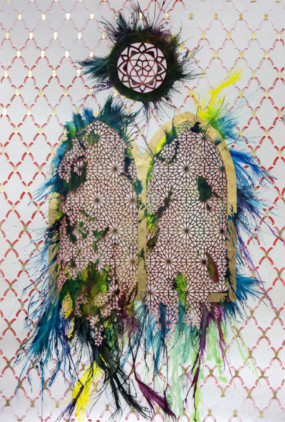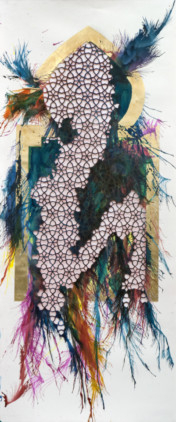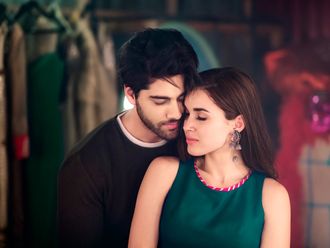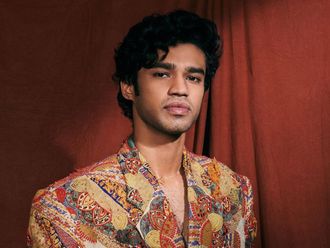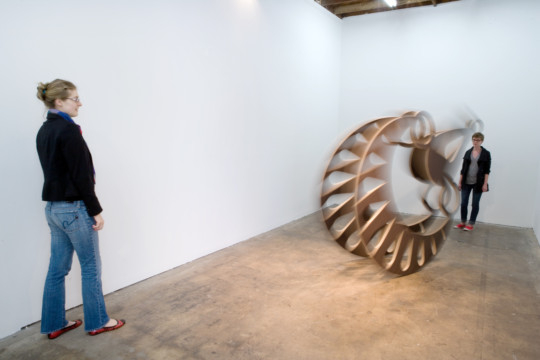
Los Angeles-based Egyptian artist Sherin Guirguis delves into the past to understand the present in her first solo show in Dubai, “Passages//Toroq”.
The show features a set of large-scale kinetic sculptures inspired by Nobel prize-winning author Naguib Mahfouz’s well-known work, “Cairo Trilogy”.
Through these sculptures the artist looks at Egyptian history to find parallels between the breakdown and reconstruction of post-colonial Egypt and the present turmoil in the country. But her main focus is on the situation of women in the past and the present, which she highlights through a series of mixed-media paintings celebrating the life of Huda Shaarawi, a pioneer of the feminist movement in Egypt.
“I recently reread the ‘Cairo Trilogy’, and realised that even though the three books are set in the past, they are so relevant today because the end of colonial rule in Egypt was a period of transition and instability, similar to the present situation in the country.
“I was particularly interested in the female characters in the books because that was also the time when the women’s movement began, and many women participated in protests demanding freedom, both from colonial rule and from restrictive cultural norms. Mahfouz’s books, which combine fact with fiction, offer insights into how the transformation in the political system in Egypt led to changes in the patriarchal society. I have tried to represent that visually in my sculptures based on the trilogy,” Guirguis says.
The three sculptures bear the same titles as Mahfouz’s books, which were named after streets in Cairo. The huge sculptures are shaped like traditional Arabian earrings and decorated with patterns found on “mashrabiyas” or latticed windows, thus alluding to the confinement of women in private spaces. And the sculptures depict movement — the body of a woman as she walks down the street.
“The first one, ‘Qasar El Shoaq’, rocks gently on a single axis, highlighting the passivity of the woman and the objectification of her body. But the next one, ‘Bien El Qasrein’ twirls, rocks and spins erratically, and quite menacingly, reflecting the empowerment of women conveyed in the corresponding book.
“The pieces are not complete until somebody moves them, thus highlighting the actions of society and individuals in shaping attitudes towards women, and the possible reactions to them. But the last piece, “El Sokareyia”, is static and the earrings are coming apart. It reflects the collapse of an old system and a transitional phase where you can see what the past was, but cannot say what the future will be. I made this after the recent revolution in Egypt, and my aim was not to project what could happen, but just to capture that moment of transition,” Guirguis says.
Her paintings explore the subject further by referencing the history of the feminist movement in Egypt. They feature life-size reproductions of traditional doorways and windows decorated with “mashrabiya” patterns hand-cut from paper and embellished with gold leaf and strokes of bright colours. The paintings are related to key moments in the feminist movement led by Huda Shaarawi.
“People are not aware that there is a strong feminist history in the Middle East. While researching the subject, I came across Shaarawi’s book, ‘The Harem Years’. She was one of the last women to actually grow up in a harem in Egypt, and she went on to become a founder and the first president of the Egyptian Women’s Union. She organised literary salons in her home to educate and empower women, and led protest marches during the Egyptian revolution of 1919. In 1923, she and her colleague Saiza Nabrawi took the bold step of removing their veils at Cairo’s Bab Al Hadid railway station.
“Shaarawi is a symbol of women’s liberation and their fight to be recognised as persons and not objects or property. I have recreated the doorway to the harem where she grew up, based on a picture in her book, and the doors and windows at Cairo station to mark these important moments of transition, and to get viewers interested in this aspect of Arab history,” Guirguis says.
“But I also know that although Egyptian women came out on the streets to join the freedom movement against British rule, after independence they were pushed back into their old position. And the history of feminism is similar around the world, including the United States, where women joined the workforce during the World Wars and returned to being homemakers afterwards.
“When I saw the women at Tahrir Square, I felt that this is a moment when we can really change our culture, and that knowing this history will help us not to repeat what happened in the past. So the title of my show, ‘Toroq’, which means passage, refers to passages in literature as well as to the passageways that we have walked through and the new passageways that have opened up after the revolution. I have used a bright palette in my paintings because despite the traumatic present and the uncertainty of this transitional phase, I want to convey a positive outlook for the future,” she concludes.
Jyoti Kalsi is an arts enthusiast based in Dubai.
The show will run at The Third Line, Al Quoz until December 7.




